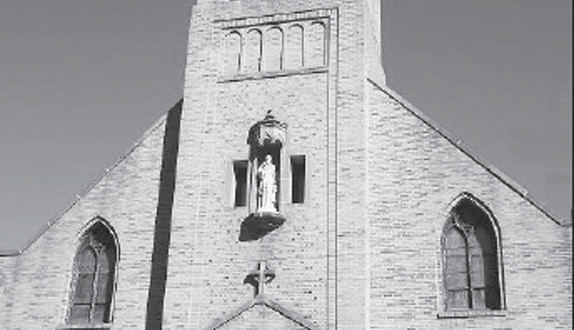by John Majikas

Lately, there has been considerable talk and worry about the closing of the Our Lady of Vilnius (Aušros Vartų) church in Manhattan, N.Y., and other Lithuanian churches in the United States. Churches that early Lithuanian immigrants built with their sweat and hardearned money a hundred or more years ago, and that served as their religious, cultural and social centers, have now become targets of U.S. archdioceses. Will this trend continue, and will others follow? This is what the parishioners of St. Vincent de Paul are asking as they get ready to celebrate their parish’s centennial.
DURING THE LATER HALF OF THE 19TH CEN- tury, Lithuanians started migrating to the United States of America – or just America as everyone called it – on a large scale, seeking a better way of life. They wanted to free themselves from the shackles of the Czar, who held them and their country subjugated to the Russian rule. They were not permitted to read or publish books in their native Lithuanian language, nor to teach their children to read or write in their own ancient language. So they left their homeland for America, and an uncertain future. Some of these early immigrants settled in the anthracite coal-mining town of Girardville, Pennsylvania.
1904 – 1907
Masses were held for these Lithuanians of Girardville as early as 1904 in the Girard Opera House (built in 1880) – the now closed Girard movie theater; and then the roller skating rink – located on the southwest corner of Main and Second Streets. In 1906 Rev. Antanas Miliukas began to form his congregation. He and several church members bought the old National Guard Armory and surrounding grounds at 260 North Second Street (corner of North Second Street and East Mahanoy Avenue), from the owner, Girard Estate in October 1907 for the sum of $8,000. Originally, there was the Girard House Hotel – built in 1832 – on this corner property facing East Mahanoy Avenue. Among the first organizers of the parish were Sylvester Bielauskas, John Greblick, Walter Marcincavage, Frank Shimulaitis, and Mr. Chapley, an uncle of Rev. Miliukas.
Enthusiasm was tremendous among the local people since they now had their own Lithuanian church. During the first year, donations for the new church amounted to $7,245.64, and another $3,588.80 for improvements and repairs.
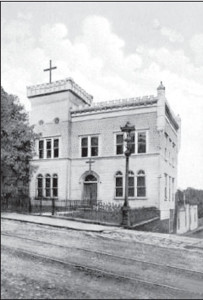
A rectory was established on Second Street – formerly the property of the Čepukaitis family. Furnishings for the church and rectory cost $2,500. This brought the total debt, during meager times, to about $5,000.
The first baptism recorded was that of George Želvis on January 27, 1907. The first marriage recorded was that of Joseph Jurgaitis and Josephine Sanavaitis on February 12, 1907. Among the first altar boys were Joseph Ackronias, Anthony Bann, and John Bernotas.
1908 – 1923
On May 23, 1908, Rev. Simnas Pautienius succeeded Rev. Miliukas. About two years later, the Archbishop appointed Rev. John Dumčius pastor on May 10, 1910. He guided the spiritual welfare of the people for about one year. From March 22 to October 11, 1911, the following also served as pastors of St. Vincent’s Parish: Rev. Taškūnas, Rev. Dvaranauckas, and Rev. Kaminskas. On October 11, 1911, Rev. Durickas was assigned as pastor. He attended to the religious needs of the parish until July 17, 1913, when Rev. Jonas Mickū- nas was appointed as his successor. He served as pastor a short time until November 22, 1913, when Rev. Dr. Pranas Augustaitis came to Girardville as the new spiritual leader.
During Rev. Augustaitis’ pastorship, a new rectory was built for the sum of $3000. A loan was obtained from the bank, and a three story wooden structure with a buff brick front was built next to the church. On November 9, 1916, Rev. Valaitis came as the new pastor. He was determined to reduce the debt of the parish and make repairs to the church property. The church building was starting to deteriorate. However, after four years of efforts, his work was in vain during those hard times of World War I.
Rev. Valaitis became sickly and downhearted, and returned to his native Lithuania. Rev. Ignatius Valančiūnas was assigned as pastor in June 15, 1920.
With the church in a very depressing condition. Rev. Valančiūnas began to make repairs. Fortunately the miners were working better and their pays were larger. Through the efforts of the pastor and parishioners, the old potbelly stoves were replaced with a coal fired, steam furnace.
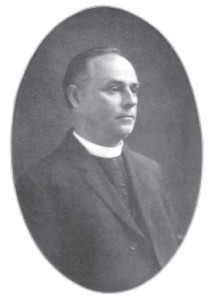
In the following four years, $7,000 of the debt was paid off. The spirit of the people was noble, and there was talk of building a new church. For two years this project was left for discussion. Some wanted the new church to be built immediately, while others were afraid of the financial burden placed upon the parishioners. Finally it was decided to build a new church. The parishioners and some fellow townspeople began the tearing down of the old Armory building in 1923. Also, they helped with the construction of the new church by digging and building the foundation. Many men, women, youth, even children, pitched in.
(Editor’s note: We recently came across a copy of the Lithuanian American Catholic Yearbook for the year 1916, which describes in detail all the Lithuanian Roman Catholic parishes in the United States ((and there were quite a few of them!)). In the description of St. Vincent de Paul Parish in Girardville, Pa., we read:) St. Vincent’s Parish, Girardville, Pa., was founded in 1907. Among its pastors were the reverends: A. Miliukas, S. Pautienius, J. Dumčius, Taškūnas, and J. Mickūnas. Since November 1913, and until this day, the pastor has been Rev. Dr. Pranas Augustaitis. There are 250 families and about 150 single persons in the parish, for a total of 1,000 souls. Most local Lithuanians work in the coal mines. Of local businesses, almost all are engaged in the sale of alcoholic beverages. The parish has these societies: St. Vincent’s, St. George’s, Knights of Lithuania, Holy Rosary (women’s), Holy Virgin Mary, a Temperance group, and two chapters of the Lietuvių Romos Katalikų Susivienijimas Amerikoje (Union of Lithuanian Roman Catholics in America.) Most parishioners are from the Suvalkija region of Lithuania. The most popular newspapers are Draugas, Palanga and Saulė. Girardville’s Lithuanians are a bunch of drunkards. Such a small group is able to keep 15 saloons in business. (We didn’t say it; we just read it in the yearbook.)
1924 – 1933
Individuals and societies donated money for the painted glass windows, the Stations of the Cross, the altar rails, the statues, and many other items in addition to their parish pledges. Some of the names of these generous individuals can still be seen on plaques or windows within the church.
During the construction of the new edifice, services were conducted in the basement of St. Joseph’s Church in Girardville.
The church is all brick in the English Gothic style of architecture. Mr. Freeman of Reading, Pennsylvania was the architect. The church cost $65,800; digging of the foundation, $5,000; the plaster work, $5,800; heating system, $7,000; the bells, $1,600; the organ, $10,000; and the pews, $4,400. The overall size of the church is 150 ft. long and 50 ft. wide.
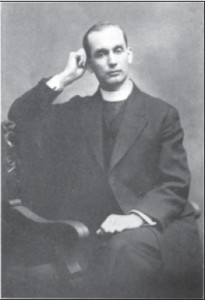
There are four bells in the church belfry having diameters measured in inches of 44, 34, 29, and 22. One bell was donated by Father Valančiū- nas, another donated by parishioner Mr. Offshany, and the remaining two purchased by the parishioners. Rev. Kaulakis of St. Casimir’s Church, Philadelphia, blessed the bells.
Also included in the construction is a large hall (auditorium) below the church that contains a raised stage, restrooms, bar, and kitchen; and a school building attached to the rear of the church. The school building has three floors with two classrooms on every floor. It was built to educate the children of the parish, but due to lack of funds it was not opened. Subsequently, it was rented to the public schools for a few years
A basketball court was installed in the auditorium and the parish sponsored both girls’ and boys’ basketball teams which were known as the St. Vincent’s Catholic Clubs. Both teams were very successful, with the girls’ basketball team winning the 1926- 1927 season championship.
On August 28, 1933 Rev. Michael Daumantas was appointed pastor and Rev. Valančiūnas transferred to Philadelphia. Rev. Daumantas, or Father Mike as he was often referred to, was a young and energetic priest who started at once to reduce the debt of the parish.
1934 – 1947
Through the efforts of the pastor and parishioners, many improvements took place. The Holy Name Society and the Holy Rosary Society spearheaded the efforts, again, to improve the church through their fundraising banquets, solicitations, and other activities. The church was repainted for the first time since it was constructed in 1924.
Finally, in September of 1939, the parishioners opened their own parochial school. The Sisters of Jesus Crucified (CJC) were invited to teach in the new school. The first Superior was Sister M. Gabriel. The school had an enrollment of 108 children.
In May 1940, Rev. Albin Neverauskas (Nevers) was assigned as the first curate (assistant) to the pastor.
From 1939 to 1945, the Sisters, who taught in the parish school, were housed on the third floor of the school. So in 1945, through the efforts of the pastor, a large and spacious convent (the Mansion) was obtained. Although the convent was a virtual gift from Girard Estate, it cost more than $13,000 to renovate and furnish. A beautiful chapel, with a pink marble altar, was constructed. Cardinal Dennis Dougherty blessed the convent on October 13, 1945. There were over 500 families in the Parish during the late 1940s.
In 1947 Rev. Jerome Bagdonas, who was also a writer for a local Lithuanian newspaper (Saulė – Mahanoy City, Pa.), succeeded Rev. Albin Neverauskas, who was transferred to another parish. In 1949, Rev. John Buikus, a displaced person (DP) from the World War II ravished, and communist-occupied Lithuania, was given a home as the second curate.
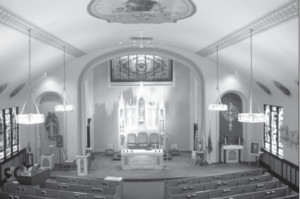
1948 – 1960
During this time. Rev. Daumantas served as treasurer of the Lithuanian Priests’ League in America, and president of the local chapter.
The church was repainted inside around 1950. In 1951, Rev. Joseph Neverauskas came as a replacement curate for Rev. Bagdonas, who was transferred to another parish.
In 1952, the building on the corner of North Second Street and East Mahanoy Avenue (100 E. Mahanoy Ave.) was purchased from Girard Estate as the new rectory. This allstone building replaced the wooden, deteriorating rectory that was adjacent to the church.
In 1953, a banquet was held for Rev. Michael Daumantas who celebrated twenty years as pastor of St. Vincent’s. Shortly afterwards, he returned to his original upstate New York home Diocese. His curate, Rev. Joseph Neverauskas was appointed pastor. A statue of Our Lady of Fatima was placed in the church and there was an annual procession led by three children who recreated the Portuguese children’s vision of the Virgin Mary.
The following church organizations were active during these years: the Holy Name Society; the Holy Rosary Society; the Third Order of St. Francis; Altar Boys Society; Sr., Jr., and Children Choir(s); Sr. and Jr. Sodalities; Field & Stream Association; Cub Scouts, Boy Scouts, and Explorer Scouts.
On May 11, 1955, Rev. Andrew Degutis was appointed pastor, and Rev. Joseph Neverauskas was transferred to St. Louis Parish (now Our Lady of Šiluva) in Maizeville, Pa. as pastor.
1961 – 1971
The Diocese of Allentown was formed on January 28, 1961 when Pope John XXIII signed a document separating the counties of Berks, Carbon, Lehigh, Northampton and Schuylkill from the Archdiocese of Philadelphia. On April 11, Bishop Joseph McShea, then auxiliary bishop of Philadelphia, was installed as the first bishop of the new diocese.
Rev. Degutis served as pastor until 1967, when Rev. J. Pascal Sabas was appointed administrator of the parish due to the illness of Rev. Degutis. Since the parish was now of mixed nationalities with English-only spoken, the Lithuanian-born curate, Father John Buikus, left for another assignment.
The church hall was remodeled in 1968. The two Catholic schools in the town were combined in mid- 1968, with the even number grade school classes held in St. Vincent’s School.
In 1970, Rev. Sabas was appointed pastor, and Rev. A. Degutis went to the diocese’s home for sick and aged priests in Newtown, Pa. The convent building (the Mansion) was sold in 1970 for $8,800. The pastor moved his residence to the unused first floor schoolrooms, and the former rectory then became the new convent.
A new rectory was planned adjacent to the church in 1970. This modern, handicap-accessible rectory became the new residence of the parish pastor.
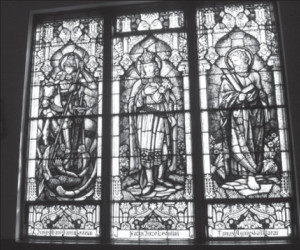
1972 – 1984
The school was closed in 1972. The Sisters of Jesus Crucified, who taught at St. Vincent’s School for 34 years, left the parish for their new assignments. The former rectory/convent building on the corner of East Mahanoy Avenue was sold for $20,000.
In September 1972, a new organ was dedicated and the Holy Rosary Society donated $4,000 towards its purchase.
On August 1, 1977, Rev. James J. Lofton became pastor and Rev. Sabas was transferred to St. Ignatius of Loyola in Sinking Springs, Pa. In March 1968, the front side of the church facing the rectory building was extensively renovated, and a ground level, handicap-accessible, side entrance was added to the church.
In September 1978, plans were finalized to begin the church renovation. The work began on October 1 and would cost $119,703. The parishioners and Friends of the Parish pledged a large amount of money for the renovation. The Holy Rosary Society bought the new side altar for $1,800.
A new altar background scene replaced the previously painted canvas picture scene. The original 1925 side altars were replaced by new scenes. New pews and carpeting were installed throughout the church. Also, the church’s front doors were replaced by metal doors with stained-glass scenes depicting old Lithuanian symbols, the occupations of the local people, and other historic motifs.
1985 – 2004
In October 1985, Rev. David Leibner replaced Rev. Lofton, who was assigned to Sacred Heart Church in New Philadelphia, Pa. As an energetic outdoors person, Rev. Leibner did much of the church grounds upkeep himself by gardening, tree removal, leaf raking, and even snow shoveling.
In January 1987, the church hall was renovated and the hall kitchen was enlarged; and in April, the Holy Rosary Society paid $1,600 for a stained glass window in the confessional.
In July 1992, a major project was undertaken when the original slate roof of the church began leaking and it was replaced with new asphalt shingles.
Former parishioners, Mr. & Mrs. Philip (Chapley) Karpousky, remembering the hard times of the coal mining parishioners in the early years of the parish, willed a large endowment ($465,000) to the Lithuanian church in 1995. This endowment is to be used to supplement any parish projects or improvements.
In July 2000, the church’s stained glass windows needed repair. The Holy Name and the Holy Rosary societies equally shared the cost and donated the $5,400 needed.
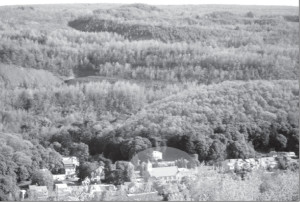
2004 – Present
On June 15, 2004, Rev. Leibner retired. Now, there was no priest in residence at the parish rectory. The Most Rev. Edward P. Cullen, Bishop of Allentown appointed Rev. Gregory R. Karpyn, the pastor of St. Joseph’s in Girardville since 2002, to also serve as the pastor of St. Vincent’s, with his residence remaining at St. Joseph’s rectory. These separate parishes are referred to as “The Catholic Churches of Girardville,” and St. Joseph’s maintenance person performed the upkeep of both parishes.
During the year, an office manager was hired to functionally operate both parishes, and he proceeded to fully computerize the rectory offices. By mid-year, a maintenance person (handyman) was also hired to do maintenance, painting, and upkeep at St. Vincent’s.
In July, Rev. Karpyn formed a St. Vincent’s Church Council. The current council members are: Marilyn Connell, John P. Gregis, Joseph Gudonis, John Majikas, Ann Vabolis, Bernice Yakera, and Thomas Yesalavage. They served as financial advisors to the pastor.
A cost-saving decision was made in mid-year to combine both Girardville Catholic Church rectories into one at St. Vincent’s.
In the fall, the parish records of St. Joseph’s were transferred to St. Vincent’s rectory. Rev. Karpyn moved his residence to St. Vincent’s rectory in November 2005, and St. Joseph’s rectory was closed.
In 2006 the pastor eliminated the position of the office manager and a new maintenance person was hired. Presently, the members of the Centennial Committee have been busy preparing for the parish’s grand celebration. A Papal blessing parchment was requested and arrived in late 2006. A Centennial 2007 booklet was printed in February 2007. Included with the booklet is a DVD which contains over 800 pictures and accompanying music that provides the viewer with a historical chronology of the parish’s past 100 years. Both are available for a donation of $10 by calling the rectory (570-276- 6033.) Celebrations, which will include a solemn High Mass and a banquet, have been scheduled for September 30, 2007.
In summary, the descendants of those early Lithuanian immigrants are still attending church in the borough of Girardville (population, approx. 1800.) At one time there were over 500 families in the parish; currently there are 130 families. Church attendance has been posted at 63 percent of the parishioners. With the planned consolidation of the parishes within the Northern Deanery of the Diocese of Allentown by 2009, the outlook for smaller parishes, like the Lithuanian St. Vincent de Paul, is uncertain.
 DRAUGAS NEWS Lithuanian World Wide News in English
DRAUGAS NEWS Lithuanian World Wide News in English
